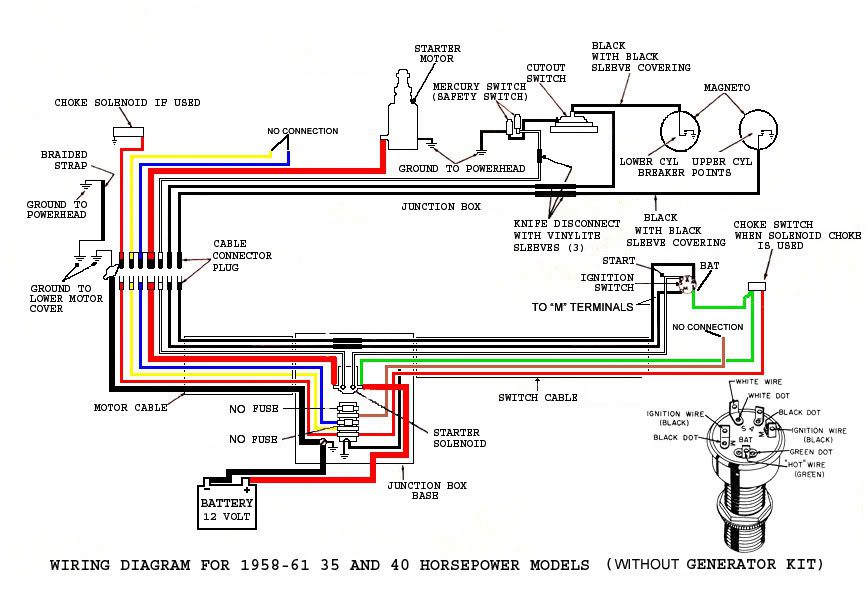Home › Forum › Ask A Member › 1958 Wire Harness short.
- This topic has 6 replies, 3 voices, and was last updated 3 months, 3 weeks ago by
 frankr.
frankr.
-
AuthorPosts
-
October 28, 2024 at 7:28 pm #291781
I have a 1958 Johnson RDE19C 35 hp. With the harness (6 pin with main 12v starter wire) wires connected to the generator, cut off/out switch and coils I get continuity between the choke wire connection and all six contacts/ pins on the motor harness. I have 2 mercury safety switches on the throttle assembly and both connect and disconnect when they are tilted. I can disconnect the choke wire from the choke and use just the wire to test and still get continuity at the harness pins. I used a second harness and get the same results. Can anyone advise? Thank you
October 28, 2024 at 9:28 pm #291782I give up, just what are you asking? It seems like you have the side connector unplugged from the motor and are checking continuity between the choke wire (disconnected from the choke) and the pin(s) at the disconnected disconnected motor side connector (not the boat-side connector). Obviously, there should be continuity at the choke pin, and no continuity to the remaining pins.
If I am reading you correctly and you are finding continuity to all the small pins under such conditions, II have to ask what are you using as a test instrument? I am guessing a digital multimeter using the Ohms test function. What Ohms test range do you have the meter set at?
If this is not correct, what is the motor doing/not doing and why are you testing it?
October 29, 2024 at 6:47 pm #291802I am using a Radio Shack analog multimeter at the continuity setting. When you touch the the two leads to each other you get a tone/beep. I would assume I have a ground short somewhere that would cause a beep. You would think that all the wires in the motor side plug would be isolated from one another but I get notice of a completed loop even from the generator poles to the choke wire. If this normal than I don’t have an issue. I have two motor side plugs and get the same issue with both.
I am in process of restoring this motor.
Thank you
October 30, 2024 at 8:42 pm #291838I guess I’m too Old School, (or just plain old), but I don’t fully understand or trust some of this newer beeping stuff.
Can you do an actual Resistance test of the circuit and report back how many OHMs you find instead of just beep and snorts? Should be infinity or
close to it.October 31, 2024 at 9:26 am #291842in order to test for shorts or opens in your wiring harness, you need to disconnect the harness from all of the components and isolate just the harness in order to do your tests. If the wiring harness is connected to all of your components, it is possible that the components are sending your continuity check through the components and back to the pins in the harness.
October 31, 2024 at 9:44 am #291843I guess I’m too Old School, (or just plain old), but I don’t fully understand or trust some of this newer beeping stuff.
Can you do an actual Resistance test of the circuit and report back how many OHMs you find instead of just beep and snorts? Should be infinity or
close to it.Frankr- New continuity meters have a function on them that emits a beep tone when you have continuity along with a visual reading on the face of the meter. This way you can test for continuity without having to look at the screen. The meter beeps if the ohm reading is below a certain level. If you hear a beep tone, continuity exists. Great option for testing circuits where you can’t see the meter screen.
October 31, 2024 at 4:24 pm #291859I guess I’m too Old School, (or just plain old), but I don’t fully understand or trust some of this newer beeping stuff.
Can you do an actual Resistance test of the circuit and report back how many OHMs you find instead of just beep and snorts? Should be infinity or
close to it.Frankr- New continuity meters have a function on them that emits a beep tone when you have continuity along with a visual reading on the face of the meter. This way you can test for continuity without having to look at the screen. The meter beeps if the ohm reading is below a certain level. If you hear a beep tone, continuity exists. Great option for testing circuits where you can’t see the meter screen.
Of course you are right. In fact, I have a beeping wonder meter myself. I guess I was just having trouble believing the OP had two cable plugs with the same problem. But considering the fact that so many of those old rubber-coated wires have age related insulation crumbling off, why not?
I remember a pilot saying something to the effect that if your instruments say you’re about to the crash, you might want to consider the fact that you just might be about to crash.
-
AuthorPosts
- You must be logged in to reply to this topic.


